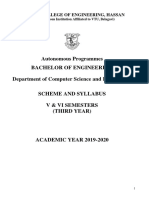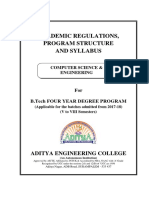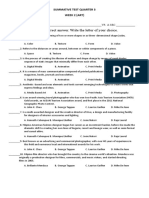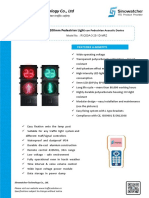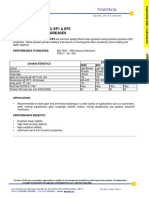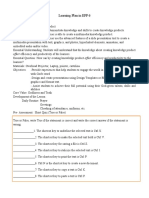Course Handout (1) Oop
Uploaded by
Harthy Ruby PriyaCourse Handout (1) Oop
Uploaded by
Harthy Ruby PriyaJ.
J College of Engineering and Technology
Course Handout
Course details:
Faculty name S.Harthy Ruby Priya
Programme B.E. (Computer Science and Engineering)
Semester III
1
Section C
Course code CS3391
Course title OBJECT ORIENTED PROGRAMMING
Prerequisite CS3251 – Programming in C
Vision of the Department of Computer Science and Engineering:
2 To provide the quality education in Computer Science and Engineering and to mould the
students into self-confident and professionally competent individuals.
Mission of the Department of Computer Science and Engineering:
M1 To produce successful graduates enriched with professional and leadership capabilities.
M2 To impart the skills necessary to continue education and to grow professionally.
3
M3 To inculcate strong ethical and human values.
M4 To establish a research centre in Computer science and Engineering.
M5 To contribute towards empowering the rural youth with computer education.
Programme Educational Objectives (PEOs):
Apply their technical competence in computer science to solve real world problems, with
PEO1
4 technical and people leadership.
PEO2 Conduct cutting edge research and develop solutions on problems of social relevance.
Work in a business environment, exhibiting team skills, work ethics, adaptability and
PEO3
lifelong learning.
5 Programme Outcomes (POs):
Engineering Knowledge: Apply the knowledge of mathematics, science, engineering
PO1 fundamentals, and an engineering specialization to the solution of complex engineering
problems.
Problem Analysis: Identify, formulate, review research literature, and analyze complex
PO2 engineering problems reaching substantiated conclusions using first principles of
mathematics, natural sciences, and engineering sciences.
Design/Development of Solutions: Design solutions for complex engineering problems and
design system components or processes that meet the specified needs with appropriate
PO3
consideration for the public health and safety, and the cultural, societal, and environmental
considerations.
PO4 Conduct Investigations of Complex Problems: Use research-based knowledge and
research methods including design of experiments, analysis and interpretation of data, and
Department of Computer Science and Engineering 1
J.J College of Engineering and Technology
synthesis of the information to provide valid conclusions.
Modern Tool Usage: Create, select, and apply appropriate techniques, resources, and
PO5 modern engineering and IT tools including prediction and modeling to complex engineering
activities with an Understand of the limitations
The Engineer and Society: Apply reasoning informed by the contextual knowledge to
PO6 assess societal, health, safety, legal and cultural issues and the consequent responsibilities
relevant to the professional engineering practice
Environment and Sustainability: Understand the impact of the professional engineering
PO7 solutions in societal and environmental contexts, and demonstrate the knowledge of, and
need for sustainable development.
Ethics: Apply ethical principles and commit to professional ethics and responsibilities and
PO8 norms of the engineering practice.
Individual and Team Work: Function effectively as an individual, and as a member or
PO9
leader in diverse teams, and in multidisciplinary settings.
Communication: Communicate effectively on complex engineering activities with the
engineering community and with society at large, such as, being able to comprehend and
PO10
write effective reports and design documentation, make effective presentations, and give and
receive clear instructions.
Project Management and Finance: Demonstrate knowledge and Understand of the
PO11 engineering and management principles and apply these to one‘s own work, as a member and
leader in a team, to manage projects and in multidisciplinary environments.
Life-Long Learning: Recognize the need for, and have the preparation and ability to engage
PO12
in independent and life-long learning in the broadest context of technological change.
Programme Specifics Outcomes (PSOs) (if any):
Exhibit design and programming skills to build and automate business solutions
PSO1
using cutting edge technologies.
6 Strong theoretical foundation leading to excellence and excitement towards research,
PSO2
to provide elegant solutions to complex problems.
Ability to work effectively with various engineering fields as a team to design, build
PSO3
and develop system applications.
Course Outcomes (COs):
CO1 Apply the concepts of classes and objects to solve simple problems.
CO2 Develop programs using inheritance, packages and interfaces.
7 Make use of exception handling mechanisms and multithreaded model to solve real world
CO3 problems.
CO4 Build Java applications with I/O packages, string classes, collections and generics concepts.
Integrate the concepts of event handling and JavaFX components and controls for developing GUI
CO5 based applications.
Correlation of COs with POs/PSOs
COs PO1 PO2 PO3 PO4 PO5 PO6 PO7 PO8 PO9 PO10 PO11 PO12 PSO1 PSO2 PSO3
CO1 1 1 3 1 3 - - - 3 2 2 2 3 1 2
CO2 2 1 3 2 1 - - - 2 1 1 3 3 3 2
CO3 3 3 1 2 2 - - - 3 2 1 2 3 1 3
8 CO4 3 1 2 2 2 - - - 1 2 1 3 3 1 1
CO5 1 1 2 3 2 - - - 3 2 1 2 3 3 3
2
Avg. 2 1 2 2 2 - - - 2 2 1 2 3 2
Department of Computer Science and Engineering 2
J.J College of Engineering and Technology
1-Low, 2-Medium, 3-High, ‘-‘ –No Correlation
Evaluation Duration Marks Date Nature of Evaluation Component
Component (50) &Time Component
As per the
Assessment Test -1 180 mins 100 Academic Closed Book Assessment Test -1
Schedule/
9
Assessment Test -2 180 mins 100 Calendar Closed Book Assessment Test -2
provided by
the
Model Exam 180 mins 100 University Closed Book Model Exam
and college
# Both assessment test 1, test 2 marks will be converted to 100.
# The total marks obtained in the two assessment tests and model exam put together out of 300, shall be
proportionately reduced for 40 marks and rounded to the nearest integer(This also implies equal weightage to
assessment test 1, assessment test 2 and model exam).
List of teaching –learning pedagogy:
● Lesson Plan and course handout
● Session Plan and session handout
● Open Hours
● Students’ seminar
10 ● Poster presentation
● Content beyond the syllabus
● Learning Management System (LMS)
● Collaborative teaching/learning-Ask a group of students to make a joint presentation
on a given topic/to solve a problem jointly
Assignments /Quiz
Open hour for students:
11
Monday
Link address for course materials:
1. www.personal.kent.edu
12 2. www.coursera.org
3. www.nptel.ac.in
4. www.edx.org
Detail academic calendar of lecture topics (date, topic, learning outcomes of each topic, related
unit of topic, total number of lecture in a unit and book/chapter to be read for the topic) (format
13
is provided with example data).
Appendix 4.1
Entire syllabus
14
Appendix 4.2
Recommended list of e-books:
15 https://freebookcentre.net/computer_books/object-oriented-programming-cpp-book-pdf.html
https://www.studytonight.com/java/notes/object-oriented-programming
Recommended list of online courses like SWAYYAM/NPTEL/MOOCS etc:
16 For NPTEL Online Course:
https://onlinecourses.nptel.ac.in/noc25_cs34/preview?utm_source
17 Students’ Presentation:
Importing Packages
Department of Computer Science and Engineering 3
J.J College of Engineering and Technology
Inter Thread Communication
Reading and Writing Files.
18 Additional information
Appendix 4.1
Detail academic calendar of lecture topics
Revised
Learning Teach
Lectur Bloom’s Cumulativ Refer
Date Topics to be covered outcomes of each ing Periods
e No. Taxonomy e Periods ences
topic Aid
level
UNIT I INTRODUCTION TO OOP AND JAVA
Describe the
Overview of OOP
basics of object -
Object Oriented
04.08.2025 oriented
Programming
1 programming BB Understand 1 1 T1
Paradigms
concepts.
Describe the basic
Features of Object- features of object
04.08.2025
2 Oriented Programming – oriented BB Understand 1 2 T1
programming.
List the
3 06.08.2025 Java Buzzwords buzzwords of BB Remember 1 3 T1
Java.
Describe the
4 07.08.2025 Overview of Java BB Understand 1 4 T1
basics of Java.
Explain the data
5 08.08.2025 Data Types, Variables types and
BB Understand 1 5 T1
variables in Java.
Apply the concept
11.08.2025 Arrays of arrays in Java Apply 1 6 T1
6 PPT
programs.
Explain the
Operators – Control concepts of
13.08.2025 BB Understand 1 7 T1
7 Statements operators and
control flow.
Programming Describe the
Structures in Java – structure of a Java
14.08.2025 FC Understand 1 8 T1
8 Defining Classes in program and
Java classes.
Apply the
concepts of
9 18.08.2025 Constructors – Methods constructors and BB Apply 1 9 T1
methods in Java
programs.
Describe about
access specifies
and static
Access Specifies – members with
10 19.08.2025 Static Members - Java examples and BB Understand 1 10 T1
Doc Comments describe about
java doc
comments.
Department of Computer Science and Engineering 4
J.J College of Engineering and Technology
UNIT II INHERITANCE, PACKAGES AND INTERFACES
Describe about
the
concepts of
Overloading Methods –
11 20.08.2025 Method BB Understand 1 11 T1
Objects as Parameters
overloading
and objects as
parameters
Describe about
the
concepts of
Overloading Methods –
12 21.08.2025 Method BB Understand 1 12 T1
Objects as Parameters
overloading
and objects as
parameters
Apply the
concepts of
22.08.2025 Static, Nested and Inner static, nested
13
Classes and inner BB Apply 1 13 T1
classes in Java
programs.
Describe about
Inheritance: Basics the need for
14 23.08.2025 BB Understand 1 14 T1
inheritance.
Elaborate the
23.08.2025 Types of Inheritance various types
15 BB Understand 1 15 T1
of inheritance.
Apply the
concepts of
super and
Super Keyword –
16 25.08.2025 method BB Apply 1 16 T1
Method Overriding
overriding in
Java
programs.
Describe about
the
Dynamic Method concept of
17 25.08.2025 BB Understand 1 17 T1
Dispatch dynamic
method
dispatch.
Explain the
concepts of
Abstract Classes – abstract
18 28.08.2025 final with Inheritance classes FC Understand 1 18 T1
and final with
inheritance.
Packages and Describe the
19 29.08.2025 Interfaces: Packages concepts of PPT Understand 1 19 T1
packages in
Department of Computer Science and Engineering 5
J.J College of Engineering and Technology
Java.
Explain the
Packages and Member concepts of
Access – Importing member access
01.09.2025 Understand
20 Packages and importing PPT 1 20 T1
packages.
Apply the
concept
21 01.09.2025 Interfaces BB Apply 1 21 T1
of interfaces in
Java programs.
UNIT III EXCEPTION HANDLING AND MULTITHREADING
Exception Handling Describe about
03.09.2025
22 basics – Multiple the concepts of BB Understand 1 22 T1
Catch handling the
Explain about
04.09.2025 Nested try Statements the nested try
23 BB Understand 1 23 T1
statements.
Describe about
Java’s Built-in the
24 15.09.2025 B Understand 1 24 T1
Exceptions built-in
exceptions.
Apply the user
User Defined defined
25 15.09.2025 BB Apply 1 25 T1
Exception exceptions in
Java programs.
Multithreaded Describe about
26 17.09.2025 Programming: Java the concept of BB Understand 1 26 T1
Thread Model thread model.
Explain about
the creation of a
Creating a Thread and
27 18.09.2025 thread and BB Understand 1 27 T1
Multiple Threads
multiple
threads.
Describe about
the concepts of
Priorities –
28 19.09.2025 priorities and FC Understand 1 28 T1
Synchronization
synchronization
in Java.
Explain about
Inter Thread the concept of
29 22.09.2025 PPT Understand 1 29 T1
Communication inter thread
communication.
30 22.09.2025 Suspending – Apply the PPT Apply 1 30 T1
Resuming and concepts of
Stopping Threads suspending,
resuming and
stopping
Department of Computer Science and Engineering 6
J.J College of Engineering and Technology
threads in Java
programs.
Describe the
Multithreading - concept of
24.09.2025 Wrappers – Auto multithreading, BB Understand 1 31 T1
31
Boxing Wrappers and
Auto Boxing
UNIT IV I/O, GENERICS, STRING HANDLING
Describe about
25.09.2025 I/O Basics the basic PPT Understand 1 32 T1
32
concepts of I/O.
Explain about
reading and
26.09.2025 Reading and Writing BB Understand 1 33 T1
33 writing console
Console I/O
I/O.
Apply reading
29.09.2025 files in Java
34 Reading Files FC Apply 1 34 T1
programs.
Apply writing
29.09.2025
35 Writing Files files in Java BB Apply 1 35 T1
programs.
Describe about
Generics: Generic the basics of
36 06.10.2025 Programming generic BB Understand 1 36 T1
programming
Apply generic
classes in Java
37 06.10.2025 Generic Classes BB Apply 1 37 T1
programs.
Apply generic
methods in Java
38 08.10.2025 Generic Methods BB Apply 1 38 T1
programs.
Describe about
the basics of
bounded types
Bounded Types -
39 09.10.2025 and Explain BB Understand 1 39 T1
Restrictions and
about the
Limitations
restrictions and
limitations
Describe about
Strings: Basic String the basics of
40 10.10.2025 PPT Understand 1 40 T1
Class Methods string
class methods.
Apply the string
buffer class in
41 22.10.2025 String Buffer Class BB Understand 1 41 T1
Java
programs.
UNIT V JAVAFX EVENT HANDLING, CONTROLS AND COMPONENTS
JAVAFX Events and Describe about
42 Controls: Event Basics the basics of BB Understand 1 42 T2
JavaFX Events.
Department of Computer Science and Engineering 7
J.J College of Engineering and Technology
23.10.2025
24.10.2025 Handling Key and Apply key and
43 PPT Apply 1 43 T2
Mouse Events mouse events.
22.10.2025 Explain about
44 Controls: Checkbox Understand 1 44 T2
the checkbox. BB
Describe about
25.10.2025 Toggle Button – Radio
the toggle and
45 Buttons BB Understand 1 45 T2
radio buttons.
Explain about
27.10.2025 List View, Combo Box the list view, FC Understand 1 46 T2
46 – ChoiceBox combo box and
choicebox
Describe about
29.10.2025 Text Controls
47 the text controls BB Understand 1 47 T2
ScrollPane
and ScrollPane.
Apply the
layouts and
Layouts – FlowPane - FlowPane in
30.10.2025
48 H Box and V Box – Java programs PPT Apply 1 48 T2
BorderPane and the HBox,
VBox and
BorderPane.
Describe about
03.11.2025
49 StackPane – GridPane the StackPane BB Apply 1 49 T2
and GridPane.
Menus – Basics Menu Describe about
04.11.2025
– Menubars – the basics of BB Understand 1 50 T2
50
MenuItem menu
Appendix 4.2
Catalog Description
To understand Object Oriented Programming concepts and basics of Java programming language. To
know the principles of packages, inheritance, and interfaces. To develop a Java application with threads
and generics classes. To define exceptions and use I/O streams. To design and build Graphical User
Interface Application using JAVAFX
TEXT BOOK:
T1: Herbert Schildt, “Java: The Complete Reference”, 11 th Edition, McGraw Hill Education, New Delhi,
2019.
T2: Herbert Schildt, “Introducing JavaFX 8 Programming”, 1 st Edition, McGraw Hill Education, New
Delhi, 2015.
REFERENCES:
1. Cay S. Horstmann, “Core Java Fundamentals”, Volume 1, 11th Edition, Prentice Hall, 2018.
Department of Computer Science and Engineering 8
J.J College of Engineering and Technology
Course Content
UNIT I INTRODUCTION TO OOP AND JAVA
9
Overview of OOP – Object oriented programming paradigms – Features of Object Oriented Programming Java
Buzzwords – Overview of Java – Data Types, Variables and Arrays – Operators – Control Statements Programming
Structures in Java – Defining classes in Java – Constructors – Methods - Access specifiers – Static members- Java Doc
comments.
UNIT II INHERITANCE, PACKAGES AND INTERFACES 9
Overloading Methods – Objects as Parameters – Returning Objects –Static, Nested and Inner Classes. Inheritance:
Basics– Types of Inheritance -Super keyword -Method Overriding – Dynamic Method Dispatch –Abstract Classes –
final with Inheritance. Packages and Interfaces: Packages – Packages and Member Access –Importing Packages –
Interfaces.
UNIT III EXCEPTION HANDLING AND MULTITHREADING 9
Exception Handling basics – Multiple catch Clauses – Nested try Statements – Java’s Built-in Exceptions – User defined
Exception. Multithreaded Programming: Java Thread Model–Creating a Thread and Multiple Threads – Priorities –
Synchronization – Inter Thread Communication - Suspending –Resuming, and Stopping Threads –Multithreading.
Wrappers – Auto boxing.
UNIT IV I/O, GENERICS, STRING HANDLING 9
I/O Basics – Reading and Writing Console I/O – Reading and Writing Files. Generics: Generic Programming – Generic
classes – Generic Methods – Bounded Types – Restrictions and Limitations. Strings: Basic String class, methods and
String Buffer Class.
UNIT V JAVAFX EVENT HANDLING, CONTROLS AND COMPONENTS 9
JAVAFX Events and Controls : Event Basics – Handling Key and Mouse Events. Controls: Checkbox,
ToggleButton – RadioButtons – ListView – ComboBox – ChoiceBox – Text Controls – ScrollPane. Layouts
– FlowPane – HBox and VBox – BorderPane – StackPane – GridPane. Menus – Basics – Menu – Menu bars
MenuItem.
Appendix 4.3: Compliance report
Department of Computer Science and Engineering
Programme B.E (CSE)
Head of the Dept Dr. K. Suresh
Compliance report of course handout
Course
Sl. Course Course handout Remarks by
Course title Section Taught by faculty
No code coordinator Submission HoD if any
date
1 CS3391 OOP C S.Harthy Ruby Priya
Department of Computer Science and Engineering 9
J.J College of Engineering and Technology
Signature of Staff In-charge Signature of H.O.D
Department of Computer Science and Engineering 10
You might also like
- Ii-Ii Sem Java Programming Coursefile (2020-21)No ratings yetIi-Ii Sem Java Programming Coursefile (2020-21)209 pages
- Course Handout - Finished2 - III YEAR B SECNo ratings yetCourse Handout - Finished2 - III YEAR B SEC14 pages
- Object Oriented Programming Through Java (Cs305es)No ratings yetObject Oriented Programming Through Java (Cs305es)17 pages
- CDP - 22AIE111 - Object Oriented Programming in JavaNo ratings yetCDP - 22AIE111 - Object Oriented Programming in Java12 pages
- Syllabus B.tech Cs Core (Batch-2024-2028)No ratings yetSyllabus B.tech Cs Core (Batch-2024-2028)173 pages
- Zero Lecture PPTIQACpptx 2025 02 06 19 39 07No ratings yetZero Lecture PPTIQACpptx 2025 02 06 19 39 0724 pages
- Assignment 8 - Professional Learning PlanNo ratings yetAssignment 8 - Professional Learning Plan8 pages
- RX200A-3-25-1D-MRZ 200mm Pedestrian + Acoustic DeviceNo ratings yetRX200A-3-25-1D-MRZ 200mm Pedestrian + Acoustic Device4 pages
- Poweroil: Power Gem Ep00, Ep0, Ep1 & Ep2 Extreme Pressure GreasesNo ratings yetPoweroil: Power Gem Ep00, Ep0, Ep1 & Ep2 Extreme Pressure Greases1 page
- Za HL 368 Big Book Original in This Together Ver 2No ratings yetZa HL 368 Big Book Original in This Together Ver 226 pages
- 25x26 House Plan From House Construction Telegu YouTube ChannelNo ratings yet25x26 House Plan From House Construction Telegu YouTube Channel1 page
- Endemism: Definition, Types, and ExamplesNo ratings yetEndemism: Definition, Types, and Examples39 pages
- Certificate of Test and Thorough Examination of Mobile CraneNo ratings yetCertificate of Test and Thorough Examination of Mobile Crane2 pages
- Efficient Market Hypothesis in The Indian Stock Market: January 2020No ratings yetEfficient Market Hypothesis in The Indian Stock Market: January 202011 pages














